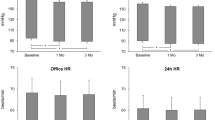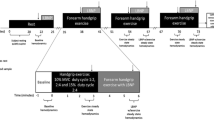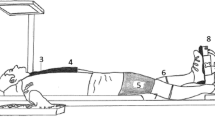Abstract
An increase in capillary blood flow and pressure in response to diabetes mellitus may lead to microangiopathy. We hypothesize that these haemodynamic changes are caused by a decreased activity of the sympathetic nervous system due to episodes of sustained hyperglycaemia. Twelve healthy volunteers consecutively underwent a hyperglycaemic experiment (HYPER), with the plasma glucose level maintained at 20 mmol.l-1 for 6 h by combined infusion of somatostatin, insulin and glucose; and a normoglycaemic experiment (NORMO), with similar infusions but with the plasma glucose maintained at fasting level. During both experiments, sympathetic nervous system (SNS) activity was measured by assessing the plasma catecholamine levels, microneurography, power spectral analysis and forearm blood flow (FBF). In an age- and weight matched group, fasting and 6-h sympathetic activity was measured without infusion of somatostatin and insulin (CONTROL). During HYPER, forearm blood flow increased from 2.45 (0.21) to 3.10 (0.48) ml.dl-1.min-1 ( P <0.05), but did not change in NORMO or CONTROL. The HYPER conditions did not change the plasma noradrenaline levels or the muscle sympathetic nerve activity [42 (4), 50 (10) and 45 (5) bursts/100 beats, HYPER, NORMO and CONTROL respectively]. Also, the power spectral analysis was similar under all experimental conditions. All results are expressed as the mean (SEM). In conclusion, sustained hyperglycaemia in normal subjects induces moderate vasodilation in skeletal muscle, but this increased blood flow can not be attributed to a decreased sympathetic tone.

Similar content being viewed by others
References
Anderson EA, Hoffman RP, Balon TW, Sinkey CA, Mark AL (1991) Hyperinsulinemia produces both sympathetic neural activation and vasodilation in normal humans. J Clin Invest 87:2246–2252
Beks PH, Mackaay AJ, de Vries H, de Neeling JN, Bouter LM, Heine RJ (1997) Carotid artery stenosis is related to blood glucose level in an elderly Caucasian population: the Hoorn study. Diabetologia 40:290–298
Bos WJ, van Goudoever J, van Montfrans GA, van den Meiracker AH, Wesseling KH (1996) Reconstruction of brachial artery pressure from noninvasive finger pressure measurements. Circulation 94:1870–1875
Brownlee M (2001) Biochemistry and molecular cell biology of diabetic complications. Nature 414:813–820
Casares S, Brumeanu TD (2001) Insights into the pathogenesis of type 1 diabetes: a hint for novel immunospecific therapies. Curr Mol Med 1:357–378
Gilligan DM, Panza JA, Kilcoyne CM, Waclawiw MA, Casino PR, Quyyumi AA (1994) Contribution of endothelium-derived nitric oxide to exercise-induced vasodilation. Circulation 90:2853–2858
Grassi G, Esler M (1999) How to assess sympathetic activity in humans. J Hypertens 17:719–734
Grunwald JE, Brucker AJ, Schwartz SS, Braunstein SN, Baker L, Petrig BL, Riva CE (1990) Diabetic glycemic control and retinal blood flow. Diabetes 39:602–607
Grunwald JE, Riva CE, Petrig BL, Brucker AJ, Schwartz SS, Braunstein SN, DuPont J, Grunwald S (1995) Strict control of glycaemia: effects on blood flow in the large retinal vessels and in the macular microcirculation. Br J Ophthalmol 79:735–741
Hausberg M, Mark AL, Hoffman RP, Sinkey CA, Anderson EA (1995) Dissociation of sympathoexcitatory and vasodilator actions of modestly elevated plasma insulin levels. J Hypertens 13:1015–1021
Hawkins M, Gabriely I, Wozniak R, Vilcu C, Shamoon H, Rossetti L (2002) Fructose improves the ability of hyperglycemia per se to regulate glucose production in type 2 diabetes. Diabetes 51:606–614
Hoffman RP, Sinkey CA, Kienzle MG, Anderson EA (1993) Muscle sympathetic nerve activity is reduced in IDDM before overt autonomic neuropathy. Diabetes 42:375–380
Hoffman RP, Sinkey CA, Anderson EA (1995) Muscle sympathetic nerve activity is higher in intensively versus conventionally treated IDDM subjects. Diabetes Care 18:287–291
Hoffman RP, Hausberg M, Sinkey CA, Anderson EA (1999) Hyperglycemia without hyperinsulinemia produces both sympathetic neural activation and vasodilation in normal humans. J Diabetes Complications 13:17–22
Hoffman RP, Sinkey CA, Dopp JM, Phillips BG (2002) Lack of effect of alpha- and beta-adrenergic inhibition on forearm glucose uptake despite differences in forearm blood flow in healthy humans. Metabolism 51:1506–1513
Kohner EM, Patel V, Rassam SM (1995) Role of blood flow and impaired autoregulation in the pathogenesis of diabetic retinopathy. Diabetes 44:603–607
Kukreja A, Cost G, Marker J, Zhang C, Sun Z, Lin-Su K, Ten S, Sanz M, Exley M, Wilson B, Porcelli S, Maclaren N (2002) Multiple immuno-regulatory defects in type-1 diabetes. J Clin Invest 109:131–140
Lenders J, Janssen GJ, Smits P, Thien T (1991) Role of the wrist cuff in forearm plethysmography. Clin Sci (Lond) 80:413–417
Moller N, Bagger JP, Schmitz O, Jorgensen JO, Ovesen P, Moller J, Alberti KG, Orskov H (1995) Somatostatin enhances insulin-stimulated glucose uptake in the perfused human forearm. J Clin Endocrinol Metab 80:1789–1793
Parati G, Saul JP, Di Rienzo M, Mancia G (1995) Spectral analysis of blood pressure and heart rate variability in evaluating cardiovascular regulation. A critical appraisal. Hypertension 25:1276–1286
Rongen GA, Senn BL, Ando S, Notarius CF, Stone JA, Floras JS (1997) Comparison of hemodynamic and sympathoneural responses to adenosine and lower body negative pressure in man. Can J Physiol Pharmacol 75:128–134
Sandeman DD, Shore AC, Tooke JE (1992) Relation of skin capillary pressure in patients with insulin-dependent diabetes mellitus to complications and metabolic control. N Engl J Med 327:760–764
Schnell O, Muhr D, Weiss M, Dresel S, Haslbeck M, Standl E (1996) Reduced myocardial 123I-metaiodobenzylguanidine uptake in newly diagnosed IDDM patients. Diabetes 45:801–805
Skyrme-Jones RA, Berry KL, O’Brien RC, Meredith IT (2000) Basal and exercise-induced skeletal muscle blood flow is augmented in type I diabetes mellitus. Clin Sci (Lond) 98:111–120
Stansberry KB, Shapiro SA, Hill MA, McNitt PM, Meyer MD, Vinik AI (1996) Impaired peripheral vasomotion in diabetes. Diabetes Care 19:715–721
Sun D, Huang A, Recchia FA, Cui Y, Messina EJ, Koller A, Kaley G (2001) Nitric oxide-mediated arteriolar dilation after endothelial deformation. Am J Physiol Heart Circ Physiol 280:H714–H721
Timmers HJ, Rongen GA, Karemaker JM, Wieling W, Marres HA, Lenders JW (2004) The role of carotid chemoreceptors in the sympathetic activation by adenosine in humans. Clin Sci (Lond) 106:75–82
Tooke JE, Morris SJ, Shore AC (1996) Microvascular functional abnormalities in diabetes: the role of the endothelium. Diabetes Res Clin Pract [Suppl] 31:S127–S132
Troni W, Carta Q, Cantello R, Caselle MT, Rainero I (1984) Peripheral nerve function and metabolic control in diabetes mellitus. Ann Neurol 16:178–183
Utriainen T, Malmstrom R, Makimattila S, Yki-Jarvinen H (1995) Methodological aspects, dose-response characteristics and causes of inter-individual variation in insulin stimulation of limb blood flow in normal subjects. Diabetologia 38:555–564
Vallet B (2002) Endothelial cell dysfunction and abnormal tissue perfusion. Crit Care Med 30:S229–S234
Vervoort G, Wetzels JF, Lutterman JA, van Doorn LG, Berden JH, Smits P (1999) Elevated skeletal muscle blood flow in noncomplicated type 1 diabetes mellitus: role of nitric oxide and sympathetic tone. Hypertension 34:1080–1085
Vollenweider L, Tappy L, Owlya R, Jequier E, Nicod P, Scherrer U (1995) Insulin-induced sympathetic activation and vasodilation in skeletal muscle. Effects of insulin resistance in lean subjects. Diabetes 44:641–645
Wallin BG, Fagius J (1988) Peripheral sympathetic neural activity in conscious humans. Annu Rev Physiol 50:565–576
Wallin BG, Sundlof G (1979) A quantitative study of muscle nerve sympathetic activity in resting normotensive and hypertensive subjects. Hypertension 1:67–77
Weston PJ, James MA, Panerai RB, McNally PG, Potter JF, Thurston H (1998) Evidence of defective cardiovascular regulation in insulin-dependent diabetic patients without clinical autonomic dysfunction. Diabetes Res Clin Pract 42:141–148
Willemsen JJ, Ross HA, Jacobs MC, Lenders JW, Thien T, Swinkels LM, Benraad TJ (1995) Highly sensitive and specific HPLC with fluorometric detection for determination of plasma epinephrine and norepinephrine applied to kinetic studies in humans. Clin Chem 41:1455–1460
Williams SB, Goldfine AB, Timimi FK, Ting HH, Roddy MA, Simonson DC, Creager MA (1998) Acute hyperglycemia attenuates endothelium-dependent vasodilation in humans in vivo. Circulation 97:1695–1701
Acknowledgements
We thank A. Jansen van Rosendaal, research nurse, for his technical assistance. This work was supported by a grant from the “Diabetes Fonds Nederland”. Cees J. Tack is the recipient of a fellowship of the Dutch Diabetes Foundation. The experiments performed in this study comply with current Dutch law.
Author information
Authors and Affiliations
Corresponding author
Rights and permissions
About this article
Cite this article
van Gurp, P.J., Rongen, G.A., Lenders, J.W.M. et al. Sustained hyperglycaemia increases muscle blood flow but does not affect sympathetic activity in resting humans. Eur J Appl Physiol 93, 648–654 (2005). https://doi.org/10.1007/s00421-004-1247-6
Accepted:
Published:
Issue Date:
DOI: https://doi.org/10.1007/s00421-004-1247-6




